Contents
Fungal diseases affect fruit trees, berries, vegetables and flowers. One way to protect the plant from the fungus is to use the fungicide Topaz. The tool has a long period of action and high efficiency. It is used both for preventive purposes and to combat existing lesions.
Features of the drug
Fungicide Topaz is a chemical agent that belongs to the class of triazoles. Its action is based on penconazole, which inhibits the functioning of fungal spores. As a result, the spread of fungal spores is stopped.
After use, the substance does not form a film on the surface of leaves and shoots. The active substance penetrates the walls of plant cells.
You can buy the product in ampoules with a capacity of 2 ml or plastic containers of 1 liter. The duration of storage of the drug is 4 years. The analogue is the drug Almaz.
Fungicide Topaz is used to combat the following diseases:
- powdery mildew;
- various types of rust on the leaves;
- oidium;
- gray rot;
- purple spotting.
Topaz is compatible with many chemicals and prolongs the positive effect of their use. The alternation of fungicides allows you to increase the effectiveness of treatments.
Most often, Topaz is used in conjunction with the following drugs:
- Horus – to get rid of Alternaria and coccomycosis;
- Kuproksat – for the treatment of phytophthora and cercosporiosis;
- Kinmiks – for pest control;
- Topsin-M – in the form of therapeutic measures when signs of anthracnose, scab, fruit rot appear.
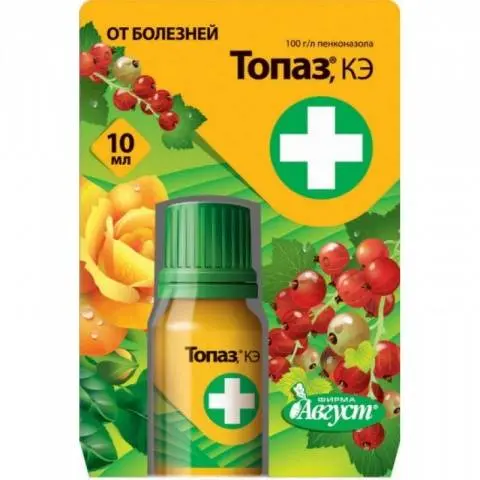
Advantages
Choosing Topaz fungicide has the following benefits:
- wide scope of application;
- a long period of exposure, allowing to reduce the number of treatments;
- good performance (the development of the fungus stops 3 hours after applying the solution);
- high efficiency at low temperatures and exposure to moisture;
- low consumption of the drug;
- suitable for most garden and flower crops;
- it is applied at any period of vegetation: from bud break to fruit ripening;
- low toxicity;
- compatibility with other means from diseases and pests.
Disadvantages
The disadvantages of Topaz fungicide include:
- the need to comply with safety regulations;
- the active substance decomposes in the soil within 2-3 weeks;
- the period of use on the site is not more than 3 years, after which a break is required;
- high toxicity to aquatic life.
Instructions for use
To obtain a working solution, first dilute the suspension in 1 liter of water. The resulting mixture is stirred, after which the required amount of water is added. The norm of Topaz fungicide is chosen according to the instructions, depending on the type of plants to be treated.
Vegetables
Topaz helps to protect cucumbers planted in a greenhouse or open ground from the spread of powdery mildew. To get a solution, take 2 ml of fungicide and 10 liters of water.
Consumption for greenhouse plants is 0,2 liters per 1 sq. m. For vegetables growing in open areas, 0,1 l is enough. Spraying is necessary when the first alarming symptoms occur.
If signs of the disease persist, the plants are treated with Topaz fungicide again after a few weeks. For vegetable crops, it is allowed to carry out no more than 4 treatments per season.
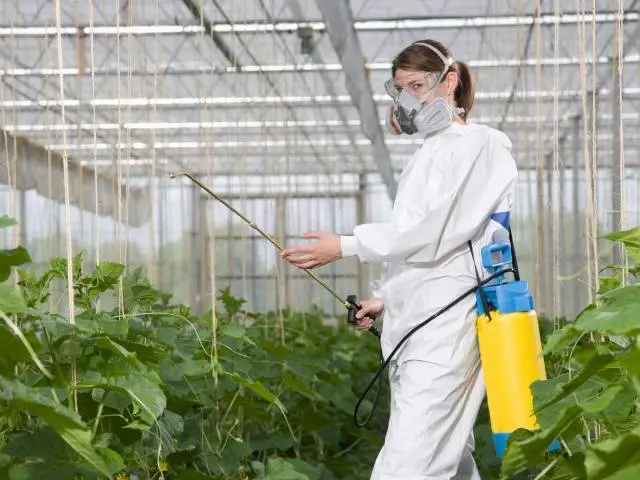
Fruit trees
Apple, pear, peach and cherry can show symptoms of fruit rot. The disease affects the fruits, which mummify and remain hanging on the branches. The disease spreads very quickly in the garden and leads to crop loss.
Another dangerous disease is powdery mildew, which looks like a whitish coating that affects shoots and foliage. Gradually, the above-ground parts of the trees are deformed and dry out.
To protect trees from diseases, a solution is prepared containing, according to the instructions for use, 1 ml of Topaz fungicide and 5 liters of water. Trees are treated by spraying. For seedlings, 2 liters of the resulting solution are used, adult trees require 5 liters.
Up to 4 treatments with Topaz are allowed per season. For preventive purposes, for spraying, choose the period of budding or after the end of flowering.
Berry bushes
Gooseberries, currants, raspberries and other berry bushes suffer from powdery mildew. A white coating appears on shoots, foliage and berries. The spread of the disease begins with the lower branches. To protect plantings from fungus, a solution is prepared consisting of 3 ml of the drug per 15 liters of water.
Treatment is carried out when the first alarming symptoms occur. Preventive spraying is performed during the formation of the first inflorescences and after flowering. During the season, it is allowed to spray shrubs 4 times. Topaz fungicide is not used 20 days before harvest and later.
Grapes
One of the most dangerous diseases of grapes is oidium. Yellowish swollen spots appear on the leaves, covered with a white bloom. Gradually, the leaves are deformed, and the inflorescences fall off.
To protect grapes from oidium, a working solution of Topaz fungicide is prepared. 2 ml of concentrate is dissolved in 10 l of water. Landings are treated by spraying on the sheet. Consumption per 10 sq. m is 1,5 liters.
The first treatment with Topaz is necessary after bud break, repeated after flowering. During the season, the number of treatments should not exceed 4.
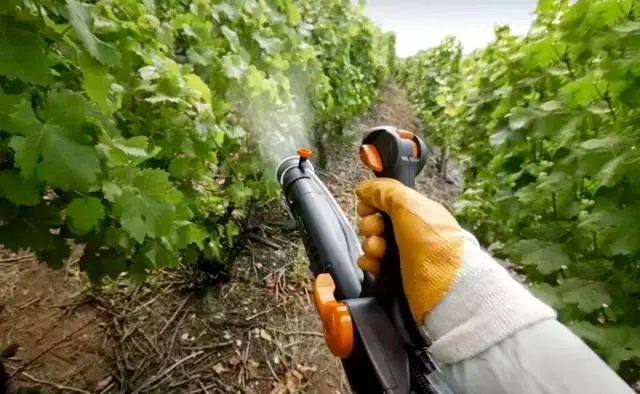
strawberry
In cold and rainy weather, signs of powdery mildew appear in the form of a white coating on strawberry leaves. As a result, the leaves curl and dry out, the berries crack and turn brown.
Another dangerous disease of strawberries is rust. Brown spots appear on the leaves, which gradually grow. As a result, the yield of strawberries falls.
To treat strawberries from fungal infections, a solution is prepared consisting of 3 ml of Topaz suspension in a large bucket of water. Plantings are sprayed on the sheet.
The first treatment is carried out before flowering. Additionally, strawberries are processed after harvesting. 2 applications of Topaz fungicide are sufficient per season.
Roses
In cold and humid climates, roses suffer from powdery mildew and rust. Signs of damage are diagnosed on the leaves of plants, as a result of which development slows down and the decorative qualities of the flower are lost.
For the treatment of roses, a solution is prepared from 4 ml of Topaz concentrate and 10 liters of water. Spraying is performed on the sheet. During the season, no more than 3 treatments are carried out. Between procedures stand 20 days.
Flower garden
Rust and powdery mildew affect flowers growing outdoors and at home. Signs of diseases occur in carnations, violets, mallows, iris, clematis, peony, chrysanthemums.
To combat diseases, a solution is prepared from 3 ml of Topaz and 10 liters of water. Leaves and shoots are sprayed in cloudy weather. If necessary, the treatment is repeated, but not more than 3 times during the season.
Safety measures
Fungicide Topaz is a substance of hazard class 3, poisonous to fish. For birds and insects, the drug does not pose a danger. When working with the substance, observe safety precautions.
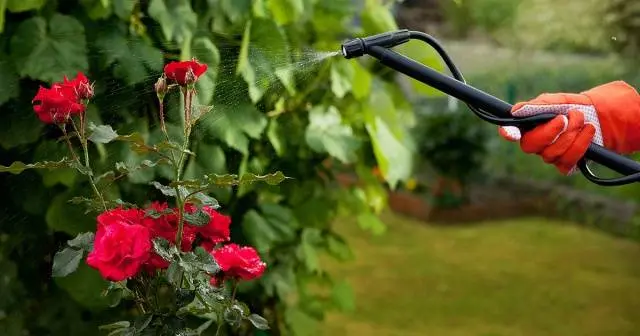
Do not smoke, eat or drink while using Topaz fungicide. Work is carried out on a dry cloudy day or in the evening. Permissible wind speed is up to 5 m/s.
When working with the solution, it is important to protect the skin and respiratory organs. It is better to use a respirator and a protective suit. People without protective equipment and animals should be at a distance of more than 150 m from the place of processing.
When administered with Topaz fungicide, it is necessary to drink 2 glasses of water and 3 tablets of activated charcoal, induce vomiting. You definitely need to see a doctor.
Reviews of gardeners
Conclusion
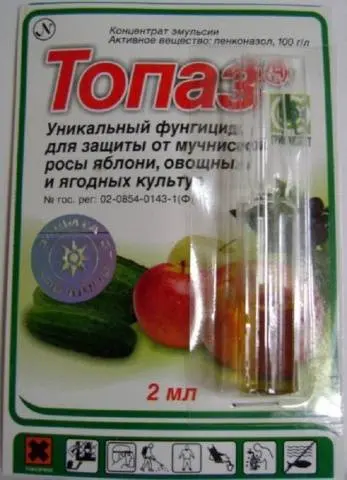
The drug Topaz effectively copes with fungal infections on vegetable and horticultural crops. Plants are treated by spraying. Fungicide is added according to the norm established for each culture. When interacting with Topaz, observe safety precautions.









